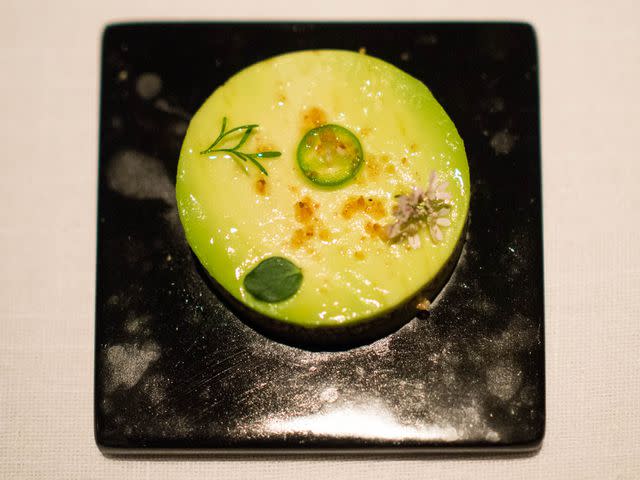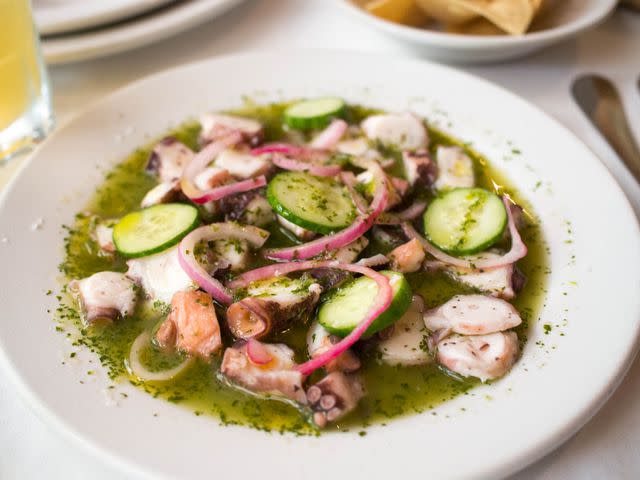How to Make Aguachile: The Chili-Spiked Mexican Ceviche
Traditionally made with raw shrimp, lime juice, chilies, cucumber, and onion, it's served immediately while still totally raw, unlike most other ceviche.

What is aguachile? Before I answer that, we need some music. Open Hector Lavoe's salsa classic Aguanile in another tab, and put it on repeat while you read this.
Why? Because first, it's a great song, and second, "aguanile" rhymes with "aguachile." My hope is that, if you're anything like me, you will forever have this song play in your head whenever you think of aguachile, with the word "aguachile" in place of the original one.
So now that we have a soundtrack, let's get back to aguachile. I was in Mexico a couple weeks ago, mostly in Mexico City with one day in Puebla and a few days in Tulum for a wedding, and among the many great things I ate there were two strikingly different versions of aguachile, a type of Mexican ceviche.
The first was at chef Enrique Olvera's great restaurant Pujol, and it is by far the most unorthodox version one is likely to see. It's also very pretty.

Pujol's "aguachile"*, part of a series of street-food-inspired snacks on the tasting menu, was made with two perfectly circular rounds of avocado sandwiching a lime-spiked chia-seed filling. The toppings included sal de gusano (worm salt), chili, herbs, and flowers; a blue corn tostada was layered in there as well.
*When a dish diverges so far from the original that even people familiar with the classic version likely wouldn't immediately recognize them as related, I feel the need to put quotation marks around the name.
Next, I had an octopus aguachile at a pretty fantastic seafood restaurant called Contramar.

This one had cooked octopus, a lime-and-chile dressing, cucumber, onions, and minced herbs.
I really enjoyed both versions, but given the differences between the two, I was left wondering what exactly aguachile is, and also what makes it different from other ceviches. Thankfully, I'm a compulsive cookbook-buyer when I travel, and I managed to pick up the Larousse guide to Mexican Cooking while there.
"The most classic version is made with fresh raw shrimp, cucumber, red onion, lime juice, and chilies (typically serranos or jalapeños) that have been pulverized with some water—hence the name."
According to Larousse, aguachile is a type of Mexican ceviche that hails from Sinaloa. The most classic version is made with fresh raw shrimp, cucumber, red onion, lime juice, and chilies (typically serranos or jalapeños) that have been pulverized with some water—hence the name. It's usually served with avocado and tostadas, and is a popular snack with beer and tequila.
One of the most interesting things about aguachile is that, unlike most ceviches, which are marinated for about 15 to 30 minutes for optimal curing time (something Kenji has written about before), aguachile is meant to be served immediately upon tossing the shrimp with the lime, which means it's just about sashimi-raw when you eat it.
Of course what this means is that it's imperative that you buy sushi-grade fish when preparing aguachile (frankly, that goes for all ceviches, but it's even more true here). In the case of shrimp, Larousse insists on finding ones that have never been frozen, a requirement that eliminates most of the shrimp sold at the fish market.
I wanted to create a recipe that was as traditional as possible, since it's not the most well-known of ceviche types, but then I also wanted to create a couple variations that stick to the same water-chile base while otherwise using different seafood and flavorings. For those who can't find raw shrimp that are good enough to serve this way, feel free to try one of the variations below. Frankly, this is all pretty interchangeable: There's no reason you couldn't do raw fish, like the arctic char below, with the shrimp marinade, or serve scallops with the habanero-marinade I made for the arctic char.
Take a look below to get familiar with aguachile in its simplest form as well as the spruced-up versions, then knock yourself out with whatever combinations of fish or shellfish (or even chia seeds!) that you'd like.
The Classic Shrimp Aguachile

Once I had the Larousse definition of an aguachile in-hand, it was pretty easy to come up with my own version of the basic recipe. The main thing here are the shrimp: Make sure to tell your trusted fishmonger that you want fresh, never frozen, shrimp, and that you will be eating them raw. If the fishmonger hesitates, move along. In many cases these shrimp will be head-on, which is a bonus since the heads are wonderful too.
The shrimp I got were gorgeous things, plump and pink even when raw.

I split them in half lengthwise and removed any veins inside.

I also followed the advice of a couple recipes I had seen online, and sprinkled the shrimp with salt, then let them stand in the refrigerator for an hour or so while I prepared everything else. I took this step with the seafood on all the recipes here: I figured it might help, given the minimal curing time with lime juice, to let the salt cure the seafood lightly.

The Larousse definition of aguachile also mentioned using a mortar and pestle to pulverize the chili, so for this version I tried that out.

It was easy to do, though I found that a light tapping motion (as opposed to a grinding motion) was the most efficient way to initially break down the pieces of serrano chile I used. Then I added a bit of water and kept working it into a chili-green fluid. Aguachile!

Then I stirred in lime juice, seasoned it with salt and pepper, and tossed it with the shrimp, cucumbers, and red onion. Listo.

And just for fun, I got a little pot of oil going and deep-fried the heads for a crispy snack.

Scallop Aguachile With Cilantro and Jalapeños

Next up, I made an aguachile with scallops. This one is still pretty close to the classic, with lime, jalapeño, cucumber, and red onion. But here I added cilantro to the marinade, since herbs seem to be a frequent addition to the basic recipe. We often find that a mortar and pestle is the best tool for extracting flavors out of moist aromatics, but in this case I tried it out with an immersion blender and was pleasantly surprised to find that it work pretty well (and is a lot less effort).
Make sure, if you get scallops, to buy dry-packed ones that have not been soaked in a brine or preservative solution. They'll cost more, but at least you're not paying for the excess water weight, and the flavor is incomparable. These scallops are often labeled "dry scallops." If the scallops you're looking at are sitting in a pool of milky liquid, that's a good sign that they've been chemically treated and you should pass them up.

This time I built the agauchile as individual servings on top of tostadas, but you can just as easily serve the whole thing on a plate with the tostadas on the side.

Arctic Char Aguachile With Habanero and Jicama

This variation is the farthest from the traditional one, with ultra-hot habanero chilies, jicama in place of cucumber, and some coriander seed and mint for extra flavor. You could just as easily use salmon or another fish, depending on what's available near you.
To prepare the fish fillet, I started by cutting off the skin, which you can ask the fishmonger to do if you don't feel comfortable doing it.
Then I cut the fillet in half lengthwise, just a hair off center from the fillet's natural division.

Then I cut on the other side of that natural division to remove any sinews, bones, or dark, oily meat that runs along it. I also cut away any other dark flesh on the fillet, which is mostly found on the skin side.


I cut each fillet-half crosswise into thin slices. Once you do this, it's ready to toss with the other ingredients and serve.

Be careful when working with habaneros: if you have rubber gloves (I didn't) I'd recommend wearing them when handling the peppers. My hands burned for a couple hours after cooking this.

Also be careful of splashing habanero juice when you blend it. I sure wouldn't want that stuff landing in my eyes.



Which was the best of the three? It's a tough call, because the office gobbled them all up pretty eagerly, but I think the favorite was probably the classic one with shrimp. If you've never tried it before and can find the shrimp, I'd say make that one first since it'll establish an aguachile baseline for you. After that, go wild.

